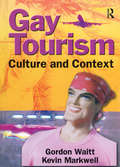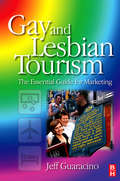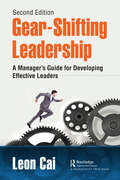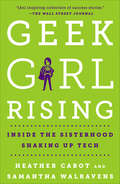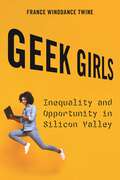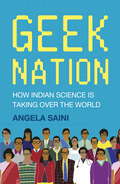- Table View
- List View
Gay Affirmative Therapy for the Straight Clinician: The Essential Guide
by Joe KortAll the answers straight clinicians need to work effectively with gay and lesbian clients. It has been over three decades since the American Psychiatric Association removed homosexuality as a category of deviant behavior from the DSM. Same-sex marriage is recognized in certain states, gay-straight alliances are springing up in high schools across the country, and major religious denominations are embracing gay clergy. Yet despite the sea change of attitudes toward homosexuality, many well-meaning straight therapists are still at a loss as to how to effectively counsel their gay and lesbian clients. This book will offer straight therapists the tools they need to counsel gay and lesbian clients effectively.
Gay Tourism: Culture and Context
by Gordon Waitt Kevin MarkwellThe gay tourism industry-a progressive social force or a pull towards an oppressive status quo?The pink tourism dollar is now recognized as a highly profitable niche of the tourism market. Gay Tourism: Culture and Context critically investigates the emergence of a commercial gay tourism industry for male clients, the way it is organized, and how the tourism industry promotes cities, resorts, and nations as &’gay&’ destinations. This careful examination critically questions the social, political, and cultural implications regarding relationships between gay tourism, Western gay male culture, the erotic, sexual politics, and sexual diversity.Gay Tourism: Culture and Context begins by detailing how travel often enabled the expression of Western same-sex male desire in the nineteenth century and then charts the emergence of a Western gay tourism industry in the late twentieth century. A critical analysis is given of gay guidebooks and erotic videos that help to establish and maintain destinations as seemingly gay utopias, including Hawaii and the Greek island Mykonos. Carefull consideration as to debates about how the gay tourism industry operates in the context of questions regarding the globalization of sexuality, sexual citizenship and place-marketing of (homo)sexualised cities. The text includes an extensive bibliography plus several photographs, charts, and figures to clearly present concepts and ideas.Topics in Gay Tourism: Culture and Context include: the history of gay travel and tourism the effect of HIV/AIDS on gay tourist destinations gay travel writing sustaining same-sex fantasies about popular gay tourist destinations analysis of the socio-political ramifications of gay tourism the sexual politics of a heterosexual nation gay tourists as an "invading force" of corruption the economic rationale for the (homo)sexualized city the concept of "gay villages" the role of special events and festivals in gay tourism and many more!Gay Tourism: Culture and Context is enlightening reading for tourism policymakers, tourism planners, tourism managers, and teachers and students in the fields of tourism studies, gay studies, social and cultural geography, and sociology.
Gay and Lesbian Tourism
by Jeff GuaracinoThis unique introductory resource provides a broad foundation of knowledge on the gay and lesbian market segment. Topics and themes are illustrated by interviewing the top professionals in gay travel and gay media who share their experience, tips for success and future predictions. Packed with best case examples and practices of existing gay tourism initiatives and campaigns, this engaging text provides analysis and context that addresses some of the burning questions in this area, including the potential negative consumer and stakeholder reaction, and strategies to educate the local hospitality community.
Gay, Inc.: The Nonprofitization of Queer Politics
by Myrl BeamA bold and provocative look at how the nonprofit sphere&’s expansion has helped—and hindered—the LGBT cause What if the very structure on which social movements rely, the nonprofit system, is reinforcing the inequalities activists seek to eliminate? That is the question at the heart of this bold reassessment of the system&’s massive expansion since the mid-1960s. Focusing on the LGBT movement, Myrl Beam argues that the conservative turn in queer movement politics, as exemplified by the shift toward marriage and legal equality, is due mostly to the movement&’s embrace of the nonprofit structure. Based on oral histories as well as archival research, and drawing on the author&’s own extensive activist work, Gay, Inc. presents four compelling case studies. Beam looks at how people at LGBT nonprofits in Minneapolis and Chicago grapple with the contradictions between radical queer social movements and their institutionalized iterations. Through interview subjects&’ incisive, funny, and heartbreaking commentaries, Beam exposes a complex world of committed people doing the best they can to effect change, and the flawed structures in which they participate, rail against, ignore, and make do. Providing a critical look at a social formation whose sanctified place in the national imagination has for too long gone unquestioned, Gay, Inc. marks a significant contribution to scholarship on sexuality, neoliberalism, and social movements.
Gaz de France
by W. Carl Kester William B. AllenThe treasurer of Gaz de France is an aggressive, proactive manager of his company's liability structure, running one of the largest swap books of any non-financial corporation in the world. Currency futures, interbank forwards, and currency options are also frequently used to control the company's multi-currency liability structure. This case prompts students to explore the reasons and ramifications of such aggressive liability management, with particular attention being paid to the administrative challenges created by such a large swap position. An important decision has to be made regarding the management of the swap book in the face of the depreciating dollar, the decline of the franc against the German mark, and a possible realignment of the European Currency Unit. This is a comprehensive case involving swaps, debt policy, and foreign exchange exposure that is best taught after students have been introduced to these topics.
Gazelle in 2012
by James Weber Andrei HagiuGazelle has pioneered a reCommerce intermediation model: it buys used electronics from consumers and resells them on eBay or to wholesalers. Going forward, its two main strategic challenges are: 1) deciding how much to rely on partnerships with large retailers for growth; 2) deciding whether to continue as a "merchant," i.e., buying and reselling goods (and thereby taking inventory risk), or to transform itself into a "two-sided platform" connecting sellers and buyers without taking inventory risk.
Gazprom (A): Energy and Strategy in Russian History
by Rawi Abdelal Sogomon Tarontsi Alexander JorovCritics have accused Gazprom, the world's largest natural gas producer, of eschewing market principles in favor of the foreign policy priorities of the Russian government, ever since the energy giant cut off the supply to Ukraine in January of 2006. The purported motive for the decision, however, seems to indicate the opposite: the company claimed that it had no other choice because the sides failed to conclude a contract on the terms of future trade. The case takes a look back in history for clues that may resolve this paradox. It highlights how politics shaped the economics of natural gas trade in the former Soviet Union and Europe since the late 1960s until the end of the 1990s; sketches the story of the creation of Gazprom by the first post-Soviet government of Russia; and describes how the erection of new sovereign borders in the wake of the dissolution of the Soviet Union, coupled with political and economic transition, created major problems in the gas trade between the former Soviet republics, emerging with the greatest intensity in the Russian-Ukrainian relations.
Gazprom (B): Energy and Strategy in a New Era
by Rawi Abdelal Sogomon Tarontsi Alexander JorovPresident Putin publicly stated that Gazprom, the largest natural gas producer in the world, was a powerful political lever of the Russian state in the world and a keystone in the foundation of the country's energy security. Thus the top leadership of Russia has charted the course of the company's future away from the seemingly imminent dismemberment, privatization, and, by implication, de-monopolization toward a challenging combination of strengthened state control, professional, transparent management, and a major expansion. The case explores how in 2000-2008 Gazprom's management has pursued the strategy defined by the politicians. Gazprom's impressive expansion strategy envisioned diversification of markets, products, transportation routes, and modes of delivery. The challenges were equally formidable: massive investment needs, a possibility of a production shortfall, and a chronic problem with the transit state of Ukraine, to name a few. In fact, Gazprom's ambitiousness fully reflected the ambitiousness of Russia as a whole, characteristic of the Putin era.
Gazprom (C): The Ukrainian Crisis and Its Aftermath
by Rawi Abdelal Sogomon Tarontsi Alexander JorovThe case describes the resolution to the January 2006 gas crisis, precipitated by the decision of Gazprom, the largest natural gas producer in the world, to cut off gas supply to Ukraine because of disagreement on the terms of future trade. The case also narrates the events that have followed: the adoption by Gazprom of a comprehensive policy to renegotiate prices with the rest of the former Soviet states; the erratic relationship with Ukraine, dependent on the internal political configuration in the latter at any given time; and a persistence of Gazprom's negative image in the world.
GeBBS Healthcare Solutions: Did You Ever Have to Make Up Your Mind?
by Josh Lerner Ann Leamon Shai Bernstein Richard SessaCase
GeBBS Healthcare Solutions: Did You Ever Have to Make Up Your Mind? (B)
by Josh Lerner Ann Leamon Shai Bernstein Richard SessaSupplement
Gear Up
by Tom Kosnik Lena Ramfelt Jonas KjellbergTransform your business idea into a high potential ventureBig, bright and brilliant, Gear Up is an engaging and practical workbook for anyone looking to pursue a fresh business opportunity or grow an existing one. Developed at Harvard Business School and Stanford University, it's a bootcamp with clear, easy-to-follow steps to test your business idea, assess its potential and make it work! Based on a revolutionary 9-component framework, Gear Up offers entrepreneurs, intrapreneurs, innovative executives and business students a toolkit to bring their ideas to life and transform them into high potential ventures.Gear Up offers a useable business tool for assessing the needs of a business idea and helps you create a plan of action to promote business success. By working through the chapters of the book, you get to create a winning strategy based on recommendations tried and tested by executives around the world.Gear Up offers: - A step by step guide to help you build a foundation for your business opportunity - Solid business framework formulated from entrepreneurs, academics and real life experience - A highly practical workbook with visual, full-colour design and compelling layoutGear Up also comes with educators' support materials available at gearupventures.comPowerPoint presentations with teaching notesOnline course materialsCourse ScheduleEvaluation FormsCertificate for students who complete the courseComing soon! - An innovative, interactive digital toolkit* Gear Up Virtual Toolkit (powered by You Noodle): A digital platform where participants can present their enterprise idea, work through the framework, answering questions and get real-time feedback from their facilitator/educator. The tool will even generate a ready-made PowerPoint presentation at the end of the process!* Gear Up Mobile App (powered by We Chat): This app allows students to answer questions from their lecturers or vote in real-time from their phones within the classroom. The app promotes student engagement and class participation.
Gear-Shifting Leadership: A Manager’s Guide for Developing Effective Leaders, Second Edition
by Leon CaiDrawn from his experience as the executive dean of Wilner Sales and Leadership Institute, Leon Cai shares his proven philosophy and methods for improving leadership skills among middle and high-level managers. Leon is one the top ten most influential trainers in China winning “Honor China Award” and is a leading figure in China’s training and consulting industry. Gear-Shifting Leadership, now in its Second Edition, is a book designed to improve leadership ability of practicing managers and addresses the full spectrum or panorama of what is expected from successful leaders. Managers need to grasp more than just one or two aspects of leadership, but the whole content and complete framework of it. Gear-Shifting Leadership, Second Edition provides the concepts, tools, and examples needed for managers to become effective leaders. Updated with new examples and tools, Gear-Shifting Leadership, Second Edition synthesizes dozens of leadership models, and fully displays "the panorama of leadership." The author demonstrates the panorama by showing the links and connections between different parts of leadership. The book displays the four gears and nineteen components of leadership managers need to develop. The four gears are: Followership, Face-to-face Leadership, In-Direct Leadership, and Organizational Executive Leadership. • Followership refers to the ability of leaders to win the trust from subordinates, superiors, and counterparts through demonstrative self-management. • Face-to-face Leadership demonstrates the leaders’ ability to drive, encourage, instruct, manage, control, and develop direct subordinates and core teams. It exhibits leaders’ one-on-one leadership abilities targeted at their direct subordinates. • Indirect Leadership shows the leaders’ influence and driving power towards indirect subordinates and the whole team, and it can be defined as the leaders’ role in managing the team as a whole. • Organizational Executive Leadership shows leaders’ acute insight of the dynamic changes in their organizations, and the leaders’ ability to optimize their own approach to managing the team and in so doing, adapt to changes in both the internal and external environment of organizations. The book walks readers through each gear as well as the several components it comprises. Many leadership books have excellent concepts and ways of thinking, but lack practical sheets, models and tools, so that books of this type can only improve leaders themselves and can’t be widely used in their organizations. Gear-Shifting Leadership illustrates the model, tables, evaluation questionnaires, and simplified tools that will make the material in this book practical and applicable.
Gearing up for Patents: The Indian Scenario
by Prabuddha GanguliThe global context of organizing industrial enterprise and conducting trade and business has radically changed since the advent of the World Trade Organization, of which India is a member.
Gebäudeautomation in Wohn- und Wirtschaftsimmobilien: Energetische Einsparpotenziale durch Gebäudeautomation (Studien zum nachhaltigen Bauen und Wirtschaften)
by Thomas Glatte Giulio SaricMit Gebäudeautomation lassen sich Komfort und Sicherheit eines Gebäudes steigern. Dazu kommt das Potenzial, die Energieeffizienz der Immobilie zu erhöhen, was wirschaftliche Vorteile bei der Bewirtschaftung mit sich bringt. Diese Publikation untersucht verschiedene Smart-Home Technologien im Hinblick auf die Senkung der Energiekosten und vergleicht den ökonomischen Nutzen zwischen Wirtschafts- und Wohnimmobilien. Dabei werden die Anwendungsfelder Beleuchtung, Klimatisierung und Beschattung analysiert und bewertet.
Gebäudeautomation in Wohngebäuden (Smart Home): Eine Analyse der Akzeptanz
by Karolin WisserNeben der Beschreibung der Gebäudeautomation aus technischer Sicht und der Erläuterung der Akzeptanzforschung, erfolgt eine differenzierte Akzeptanzanalyse. Zum einen wird die bloße Einstellung der Menschen zur Gebäudeautomation in Wohngebäuden untersucht, zum anderen werden die Faktoren analysiert, die zu einer Anschaffung der Gebäudeautomation führen oder diese verhindern. Darüber hinaus wird die Nutzungsphase, genauer die Akzeptanz bei der tatsächlichen Nutzung betrachtet. Beleuchtet werden zudem die Potenziale dieser Technologie und deren Realisierung.
Gebäudetechnik und Technischer Ausbau von Gebäuden
by Dirk BohneAuf dem neuesten “Stand der Technik” präsentiert sich das Buch noch übersichtlicher mit einer neu gegliederten, äußerst benutzerfreundlichen Darbietung des Stoffes. Das Fachwissen wurde dabei konzentriert und komprimiert auf die für Architekten und Bauingenieure relevanten Sachverhalte und Zusammenhänge. Komplett neu gestaltet wurde der umfangreiche Abbildungsteil mit hochwertigen Zeichnungen zur bildhaften Kommentierung des Textes. Um im Technischen Ausbau mit der technologischen Entwicklung, den steigenden Komfortansprüchen und den Erfordernissen eines wirtschaftlichen und umweltfreundlichen Umgangs mit der Energie Schritt zu halten, ist der “Wellpott/ Bohne” weiterhin ein unverzichtbares Grundlagenbuch.
Geek Doctor: Life as Healthcare CIO (HIMSS Book Series)
by John D. HalamkaIn his highly regarded blog, Life as a Healthcare CIO, John Halamka records his experiences with health IT leadership, infrastructure, applications, policies, management, governance, and standardization of data. But he also muses on topics such as reducing our carbon footprint, sustainable farming, mountain climbing, being a husband, father and son
Geek Girl Rising: Inside the Sisterhood Shaking Up Tech
by Heather Cabot Samantha Walravens"I don’t know much about tech, but I do know that these pioneer women are pretty dope. Geek Girl Rising gives a much needed voice to the fearless women paving an important path in the tech world, while forming a lasting sisterhood along the way.” - Kelly RipaMeet the women who aren’t asking permission from Silicon Valley to chase their dreams. They are going for it—building cutting-edge tech startups, investing in each other’s ventures, crushing male hacker stereotypes, and rallying the next generation of women in tech. With a nod to tech trailblazers like Sheryl Sandberg and Marissa Mayer, Geek Girl Rising introduces readers to the fearless female founders, technologists, and innovators fighting at a grassroots level for an ownership stake in the revolution that’s changing the way we live, work, and connect. Readers will meet Debbie Sterling, inventor of GoldieBlox, the first engineering toy for girls, which topples the notion that only boys can build; peek inside YouTube sensation Michelle Phan’s ipsy studios, where she is grooming the next generation of digital video stars while leading her own mega e-commerce beauty business; and tour the headquarters of The Muse, the hottest career site for millennials, and meet its intrepid CEO, Kathryn Minshew, who stared down sexism while raising millions of dollars to fund the company she co-founded. These women are the rebels proving that a female point of view matters in the age of technology and can rock big returns if you have a big idea and the passion to build it.
Geek Girls: Inequality and Opportunity in Silicon Valley
by France Winddance TwineChoice Outstanding Academic Title for 2023An inside account of gender and racial discrimination in the high-tech industryWhy is being a computer “geek” still perceived to be a masculine occupation? Why do men continue to greatly outnumber women in the high-technology industry? Since 2014, a growing number of employment discrimination lawsuits has called attention to a persistent pattern of gender discrimination in the tech world. Much has been written about the industry’s failure to adequately address gender and racial inequalities, yet rarely have we gotten an intimate look inside these companies. In Geek Girls, France Winddance Twine provides the first book by a sociologist that “lifts the Silicon veil” to provide firsthand accounts of inequality and opportunity in the tech ecosystem. This work draws on close to a hundred interviews with male and female technology workers of diverse racial, ethnic, and educational backgrounds who are currently employed at tech firms such as Apple, Facebook, Google, and Twitter, and at various start-ups in the San Francisco Bay area. Geek Girls captures what it is like to work as a technically skilled woman in Silicon Valley. With a sharp eye for detail and compelling testimonials from industry insiders, Twine shows how the technology industry remains rigged against women, and especially Black, Latinx, and Native American women from working class backgrounds. From recruitment and hiring practices that give priority to those with family, friends, and classmates employed in the industry, to social and educational segregation, to academic prestige hierarchies, Twine reveals how women are blocked from entering this industry. Women who do not belong to the dominant ethnic groups in the industry are denied employment opportunities, and even actively pushed out, despite their technical skills and qualifications. While the technology firms strongly embrace the rhetoric of diversity and oppose discrimination in the workplace, Twine argues that closed social networks and routine hiring practices described by employees reinforce the status quo and reproduce inequality. The myth of meritocracy and gender stereotypes operate in tandem to produce a culture where the use of race-, color-, and power-evasive language makes it difficult for individuals to name the micro-aggressions and forms of discrimination that they experience. Twine offers concrete insights into how the technology industry can address ongoing racial and gender disparities, create more transparency and empower women from underrepresented groups, who continued to be denied opportunities.
Geek Nation: How Indian Science is Taking Over the World
by Angela SainiIndia: it's a nation of geeks, swots and nerds. Almost one in five of all medical and dental staff in the UK is of Indian origin, and one in six employed scientists with science or engineering doctorates in the US is Asian. By the turn of the millennium, there were even claims that a third of all engineers in Silicon Valley were of Indian origin, with Indians running 750 of its tech companies. At the dawn of this scientific revolution, Geek Nation is a journey to meet the inventors, engineers and young scientists helping to give birth to the world?s next scientific superpower ? a nation built not on conquest, oil or minerals, but on the scientific ingenuity of its people. Angela Saini explains how ancient science is giving way to new, and how the technology of the wealthy are passing on to the poor. Delving inside the psyche of India?s science-hungry citizens, she explores the reason why the government of the most religious country on earth has put its faith in science and technology.Through witty first-hand reportage and penetrative analysis, Geek Nation explains what this means for the rest of the world, and how a spiritual nation squares its soul with hard rationality. Full of curious, colourful characters and gripping stories, it describes India through its people ? a nation of geeks.curious, colourful characters and gripping stories, it describes India through its people ? a nation of geeks.
Geek Nation: How Indian Science is Taking Over the World
by Angela SainiIndia: it's a nation of geeks, swots and nerds. Almost one in five of all medical and dental staff in the UK is of Indian origin, and one in six employed scientists with science or engineering doctorates in the US is Asian. By the turn of the millennium, there were even claims that a third of all engineers in Silicon Valley were of Indian origin, with Indians running 750 of its tech companies. At the dawn of this scientific revolution, Geek Nation is a journey to meet the inventors, engineers and young scientists helping to give birth to the world’s next scientific superpower – a nation built not on conquest, oil or minerals, but on the scientific ingenuity of its people. Angela Saini explains how ancient science is giving way to new, and how the technology of the wealthy are passing on to the poor. Delving inside the psyche of India’s science-hungry citizens, she explores the reason why the government of the most religious country on earth has put its faith in science and technology.Through witty first-hand reportage and penetrative analysis, Geek Nation explains what this means for the rest of the world, and how a spiritual nation squares its soul with hard rationality. Full of curious, colourful characters and gripping stories, it describes India through its people – a nation of geeks.curious, colourful characters and gripping stories, it describes India through its people – a nation of geeks.
Geeks Who Can Schmooze: A Credit Suisse Private Banker Tells All
by W. E. KiddW.E. Kidd shares his journey after graduating with his MBA and landing his dream job at Credit Suisse. But getting the job is just half the battle and after an intensive training period in Zurich and New York he's left to fend for himself - one man and his student loans against a two-year ticking clock to bring in forty million dollars or get fired. How he strives to make those essential connections and eventually bring in far more than forty million....and what happens to those that can't make the cut, proves mind blowing. Because it's all about the schmooze.Infused with hilarious references to the "Wall Street" films, indie rock music, and a devil may care attitude, this is not your father's Wall Street tell-all."The book is a frank, well-written account that only an insider could tell."- Scott Kays, President, Kays Financial Advisory Corporation, and author of FIVE KEY LESSONS FROM TOP MONEY MANAGERS"... a hilarious memoir by a freshly minted MBA getting his first job as a Private Banker/Wealth Builder."- Sanjeev Prakash, Top 500 Amazon Reviewer
Geeli
by Kenneth A. Froot Li Jin May YuA well-performing Chinese manufacturer faces major impediments raising funding to grow. Highlights various imperfections that shape the financing decision.
Geely SEA: New Electric Vehicle Platforms
by Shu Lin Willy ShihKent Bovellan, the Chief Engineer and Head of the Vehicle Architecture Center for Geely Holding, the Hangzhou, China headquartered global automotive group, was debating the platform choice for an upcoming "D" segment midsized battery electric vehicle (BEV). He had led the architectural development of the new Geely SEA platforms for its new family of BEVs. The new car would be part of the Zeekr premium lineup. He knew that smaller cars on a given platform inevitably suffered from costs problems, while larger vehicles suffered from less than premium attributes. They could emphasize meeting cost targets on the low end, but that might have a negative impact on the high end. Which platform should they choose? This case explores the platforms and derivatives strategies used by global auto manufacturers, and some of the changes wrought by the shift from internal combustion vehicles to battery electric. It emphasizes the importance of achieving volume and scale in reaching competitive costs and selling prices, and offers an opportunity to explore the potential impact of open standards and modular interchangeability on the structure of the industry.

